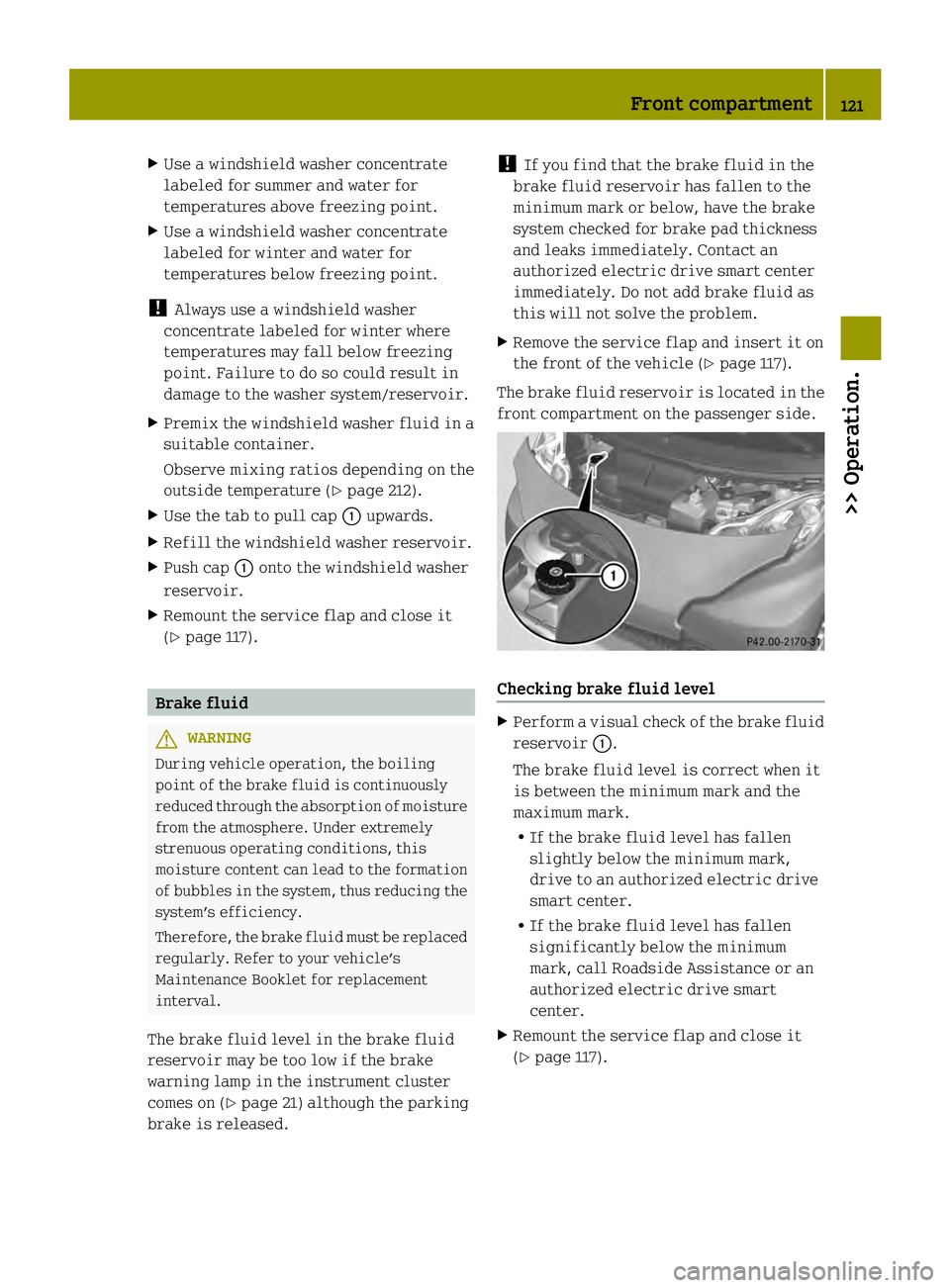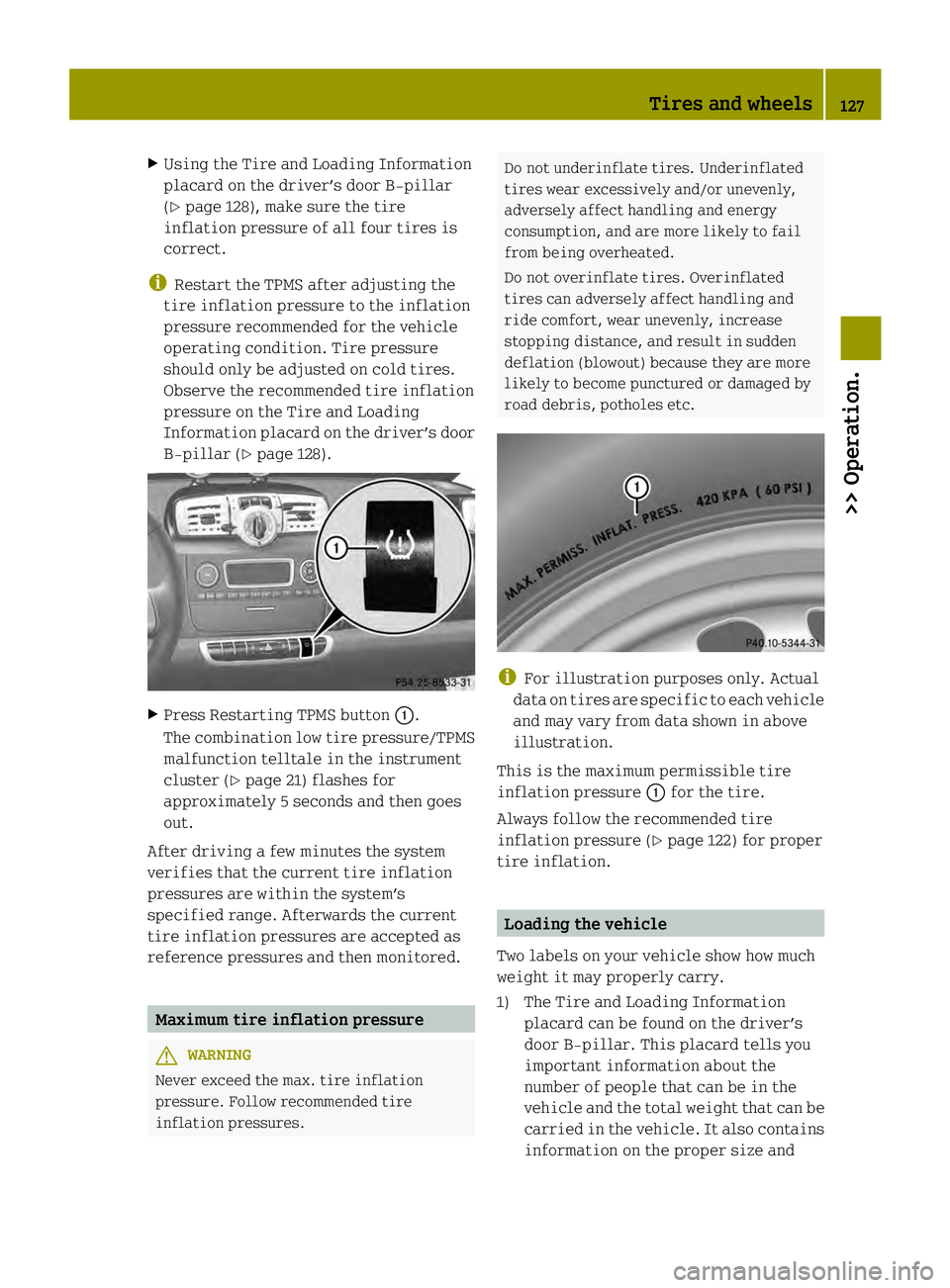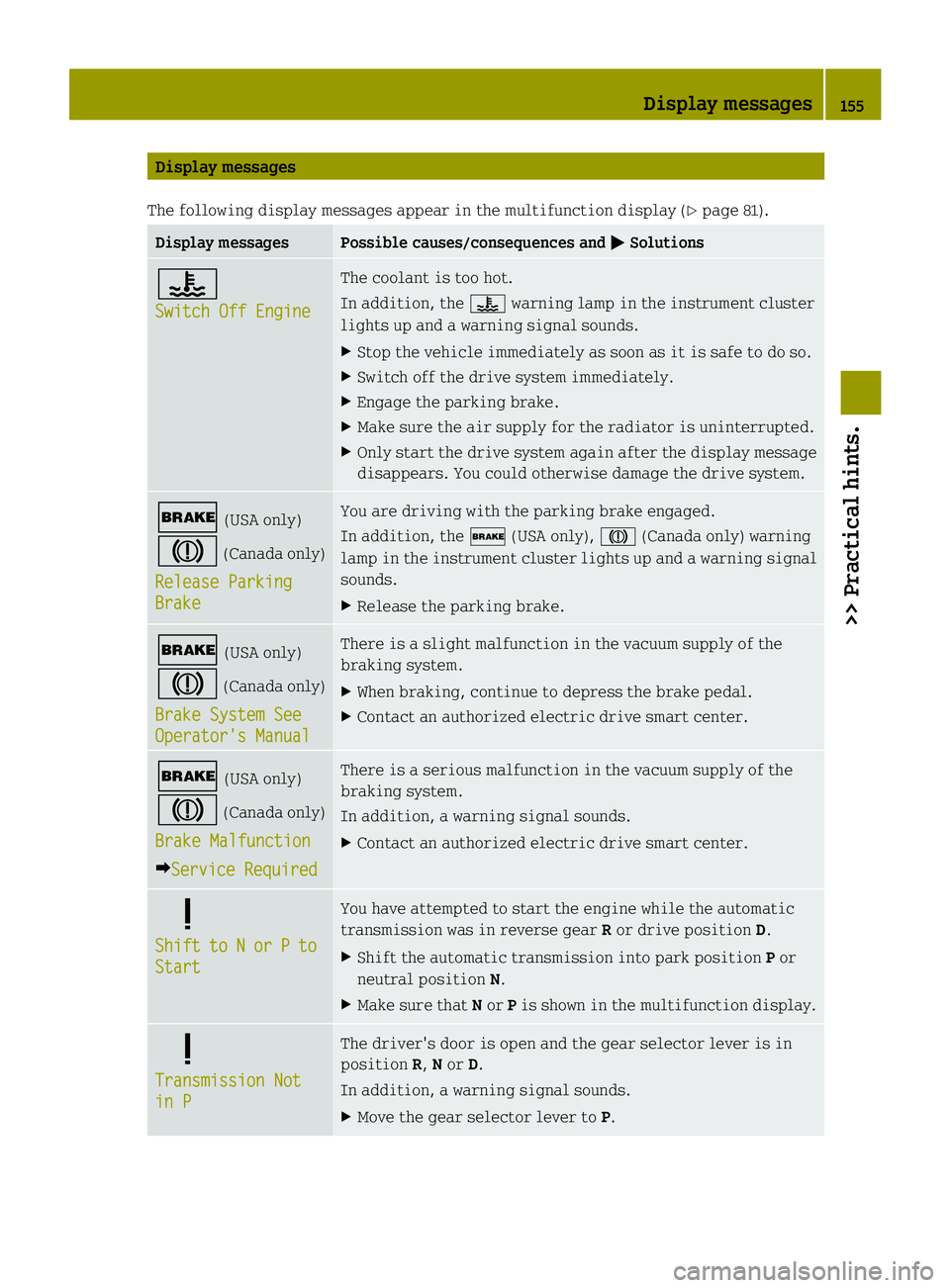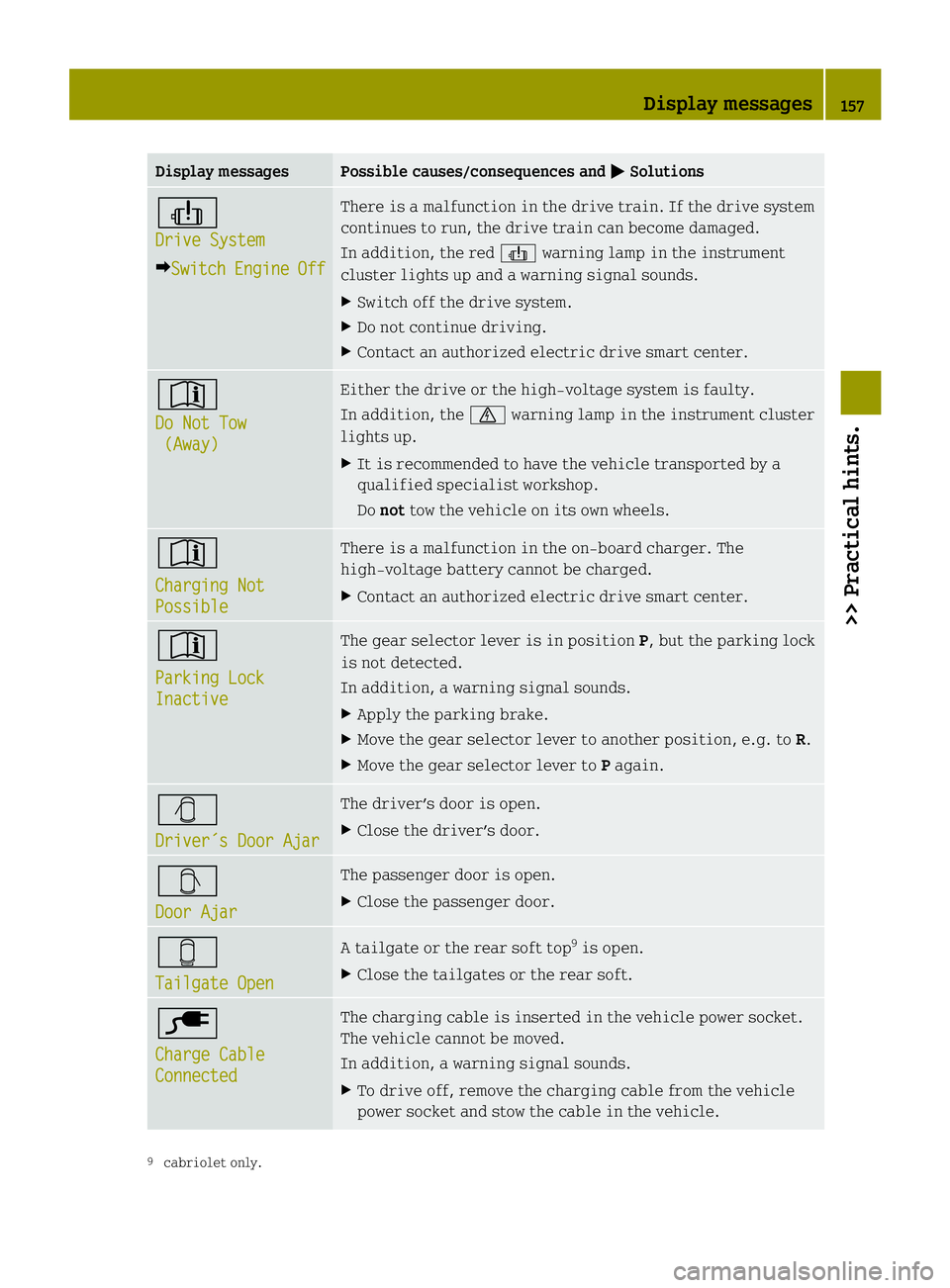2013 SMART FORTWO COUPE ELECTRIC DRIVE instrument cluster
[x] Cancel search: instrument clusterPage 123 of 218

X
Use a windshield washer concentrate
labeled for summer and water for
temperatures above freezing point.
X Use a windshield washer concentrate
labeled for winter and water for
temperatures below freezing point.
! Always use a windshield washer
concentrate labeled for winter where
temperatures may fall below freezing
point. Failure to do so could result in
damage to the washer system/reservoir.
X Premix the windshield washer fluid in a
suitable container.
Observe mixing ratios depending on the
outside temperature (Y page 212).
X Use the tab to pull cap 0002upwards.
X Refill the windshield washer reservoir.
X Push cap 0002onto the windshield washer
reservoir.
X Remount the service flap and close it
(Y page 117). Brake fluid
G
WARNING
During vehicle operation, the boiling
point of the brake fluid is continuously
reduced through the absorptio nofmoisture
from the atmosphere. Under extremely
strenuous operating conditions, this
moisture content can lead to the formation
of bubbles in the system, thus reducing the
system’s efficiency.
Therefore, the brake fluid must be replaced
regularly. Refer to your vehicle’s
Maintenance Booklet for replacement
interval.
The brake fluid level in the brake fluid
reservoir may be too low if the brake
warning lamp in the instrument cluster
comes on (Y page 21) although the parking
brake is released. !
If you find that the brake fluid in the
brake fluid reservoir has fallen to the
minimum mark or below, have the brake
system checked for brake pad thickness
and leaks immediately. Contact an
authorized electric drive smart center
immediately. Do not add brake fluid as
this will not solve the problem.
X Remove the service flap and insert it on
the front of the vehicle (Y page 117).
The brake fluid reservoir is located in the
front compartment on the passenger side. Checking brake fluid level
X
Perform a visual check of the brake fluid
reservoir 0002.
The brake fluid level is correct when it
is between the minimum mark and the
maximum mark.
R If the brake fluid level has fallen
slightly below the minimum mark,
drive to an authorized electric drive
smart center.
R If the brake fluid level has fallen
significantly below the minimum
mark, call Roadside Assistance or an
authorized electric drive smart
center.
X Remount the service flap and close it
(Y page 117). Front compartment
121>> Operation. Z
Page 127 of 218

Checking tire inflation pressure
manually
Follow the steps below to achieve correct
tire inflation pressure:
X Remove the cap from the valve on one tire.
X Firmly press a tire gauge onto the valve.
X Read the tire inflation pressure on tire
gauge and check against the
recommended tire inflation pressure on
the Tire and Loading Information
placard on the driver’s door B‑pillar
(Y page 128). If necessary, add air to
achieve the recommended tire inflation
pressure.
X If you have overfilled the tire, release
tire inflation pressure by pushing the
metal stem of the valve with e.g. a tip of
a pen. Then recheck the tire inflation
pressure with the tire gauge.
X Install the valve cap.
X Repeat this procedure for each tire.
Tire Pressure Monitoring System
(TPMS)* Your vehicle may be equipped with a
Tire
Pressure Monitoring System (TPMS).
It monitors the tire inflation pressure in
all four tires .Awarning is issued to alert
you to a decrease in pressure in one or more
of the tires.
The Tire Pressure Monitoring System
(TPMS) is equipped with a combination low
tire pressure/TPMS malfunction telltale in
the instrument cluster. Depending on how
the telltale illuminates, it indicates a low
tire pressure condition or a malfunction in
the TPMS system itself:
R If the telltale illuminates continuously,
one or more of your tires is significantly
underinflated. There is no malfunction
in the TPMS.
R If the telltale flashes for 60 seconds and
then stays illuminated, the TPMS system
itself is not operating properly. The TPMS only functions on wheels that are
equipped with the proper electronic
sensors. G
WARNING
The TPMS does not indicate a warning for
wrongly selected inflation pressures.
Always adjust tire inflation pressure
according to the Tire and Loading
Information placard on the driver’s door
B‑pillar.
The TPMS is not able to issue a warning due
to a sudden dramatic loss of pressure (e.g.
tire blowout caused by a foreign object). In
this case bring the vehicle to a halt by
carefully applying the brakes and avoiding
abrupt steering maneuvers. G
WARNING
Each tire should be checked monthly when
cold and inflated to the inflation pressure
recommended by the vehicle manufacturer
on the Tire and Loading Information
placard. If your vehicle has tires of a
different size than the size indicated on
the Tire and Loading Information placard,
you should determine the proper tire
inflation pressure for those tires.
As an added safety feature, your vehicle has
been equipped with a tire pressure
monitoring system (TPMS) that illuminates
a low tire pressure telltale when one or
more of your tires is significantly
underinflated.
Accordingly, when the low tire pressure
telltale illuminates, you should stop and
check your tires as soon as possible, and
inflate them to the proper pressure.
Driving on a significantly underinflated
tire causes the tire to overheat and can lead
to tire failure.
Underinflation also increases energy
consumption, reduces tire tread life, and
may affect the vehicle’s handling and
stopping ability. Please note that the TPMS
is not a substitute for proper tire
maintenance, and it is the driver’s Tires and wheels
125>> Operation.
* optional Z
Page 129 of 218

X
Using the Tire and Loading Information
placard on the driver’s door B‑pillar
(Y page 128), make sure the tire
inflation pressure of all four tires is
correct.
i Restart the TPMS after adjusting the
tire inflation pressure to the inflation
pressure recommended for the vehicle
operating condition. Tire pressure
should only be adjusted on cold tires.
Observe the recommended tire inflation
pressure on the Tire and Loading
Informatio nplacard on the driver’s door
B‑pillar (Y page 128). X
Press Restarting TPMS button 0002.
The combination low tire pressure/TPMS
malfunction telltale in the instrument
cluster (Y page 21) flashes for
approximately 5 seconds and then goes
out.
After driving a few minutes the system
verifies that the current tire inflation
pressures are within the system’s
specified range. Afterwards the current
tire inflation pressures are accepted as
reference pressures and then monitored. Maximum tire inflation pressure
G
WARNING
Never exceed the max. tire inflation
pressure. Follow recommended tire
inflation pressures. Do not underinflate tires. Underinflated
tires wear excessively and/or unevenly,
adversely affect handling and energy
consumption, and are more likely to fail
from being overheated.
Do not overinflate tires. Overinflated
tires can adversely affect handling and
ride comfort, wear unevenly, increase
stopping distance, and result in sudden
deflation (blowout) because they are more
likely to become punctured or damaged by
road debris, potholes etc. i
For illustration purposes only. Actual
data on tires are specific to each vehicle
and may vary from data shown in above
illustration.
This is the maximum permissible tire
inflation pressure 0002for the tire.
Always follow the recommended tire
inflation pressure (Y page 122) for proper
tire inflation. Loading the vehicle
Two labels on your vehicle show how much
weight it may properly carry.
1) The Tire and Loading Information placard can be found on the driver’s
door B‑pillar. This placard tells you
important information about the
number of people that can be in the
vehicle and the total weight that can be
carried in the vehicle. It also contains
information on the proper size and Tires and wheels
127>> Operation. Z
Page 144 of 218

systems. In this case, it is important to
keep in mind that a considerably higher
degree of effort is necessary to brake and
steer the vehicle. Adapt your driving
accordingly.
Brakes
G
WARNING
Make sure not to endanger any other road
users when carrying out braking
maneuvers.
Refer to the description of the hydraulic
brake assistant (Y page 46).
! Because the ESP ®
operates
automatically, the ignition must be
switched off when the parking brake is
being tested on a brake test
dynamometer. Active braking action
through the ESP ®
may otherwise seriously
damage the brake system which is not
covered by the smart Limited Warranty.
Brake pad wear or a leak in the brake system
may be the reason for low brake fluid level
in the brake fluid reservoir.
The brake fluid level in the brake fluid
reservoir may be too low if the brake
warning lamp in the instrument cluster
comes on (Y page 21) although the parking
brake is released.
Have the brake system inspected
immediately. Contact an authorized
electric drive smart center.
All checks and service work on the brake
system should be carried out by qualified
technicians only. Contact an authorized
electric drive smart center.
Only install brake pads and use brake fluid
recommended by smart.
Inclines When driving down long and steep grades,
do not depress the brake pedal permanently. Depress it in intervals
instead to reduce the vehicle speed. G
WARNING
Resting your foot on the brake pedal will
cause excessive and premature wear of the
brake pads.
It can also result in the brakes
overheating, thereby significantly
reducing their effectiveness and your
ability to stop the vehicle in sufficient
time to avoid an accident.
High and low stresses After hard braking
,it is advisabl eto drive
on for some time, rather than immediately
park, so that the air stream will cool down
the brakes faster.
If your brake system is normally only
subjected to moderate loads, you should
occasionally test the effectiveness of the
brakes by applying above-normal braking
pressure at higher speeds. This will also
enhance the grip of the brake pads. G
WARNING
Make sure not to endanger any other road
users when carrying out these braking
maneuvers.
Wet road surface G
WARNING
After driving in heavy rain for some time
without applying the brakes or through
water deep enough to wet brake components,
the first braking action may be somewhat
reduced and increased pedal pressure may
be necessary to obtain expected braking
effect. Maintain a safe distance from
vehicles in front.
To help prevent brake disc corrosion after
driving on wet road surfaces (particularly
salted roads), it is advisable to brake the
vehicle with considerable force prior to 142
Driving instructions>> Operation.
Page 148 of 218

!
Water in these areas could cause
damage to
R electrical components
R electrical wiring
R the drive system
R the high-voltage battery
Any such damage is not covered by the
smart Limited Warranty. Passenger compartment
G
WARNING
Always fasten items being carried as
securely as possible.
In an accident, during hard braking or
sudden maneuvers, loose items thrown
around inside the vehicle may injure
vehicle occupants.
The cargo compartment is the preferred
place to carry objects. Control and operation of radio
transmitters
Radio and telephone G
WARNING
Please do not forget that your primary
responsibility is to drive the vehicle
safely. Only operate the radio or
telephone 8
if road, weather and traffic
conditions permit.
Bear in mind that at a speed of just 30 mph
(approximately 50 km/h), your vehicle is
covering adistance of 44 feet
(approximately 14 m) every second.
Telephones and two-way radios G
WARNING
Never operate radio transmitters equipped
with a built-in or attached antenna (i.e.
without being connected to an external antenna) from inside the vehicle while the
drive system is switched on. Doing so could
lead to a malfunction of the vehicle’s
electronic system, possibly resulting in an
accident and/or serious personal injury.
Radio transmitters, such as a mobile phone
or a citizens band unit should only be used
inside the vehicle if they are connected to
an antenna that is installed on the outside
of the vehicle.
Refer to the radio transmitter operation
instructions regarding use of an external
antenna. Coolant temperature
During severe operating conditions and
stop-and-go city traffic, the coolant
temperature may rise.
! Excessive coolant temperature causes
the red coolant temperature warning
lamp 0005 in the instrument cluster to
come on.
The drive system should not be operated
with the red coolant temperature
warning lamp 0005illuminated. Doing
so may cause serious damage to the drive
system and the high-voltage battery,
which is not covered by the smart Limited
Warranty.
For more information on coolant
temperature warning lamp ( Ypage 165). Driving abroad
Abroad, there is an extensive smart service
network at your disposal. If you plan to
drive into areas which are not listed in the
index of your smart center directory, you
should request pertinent information from
an authorized electric drive smart center.
8 Observe all legal requirements. 146
Driving abroad>> Operation.
Page 157 of 218

Display messages
The following display messages appear in the multifunction displa y(Ypage 81). Display messages Possible causes/consequences and
0001 Solutions
0005
Switch Off Engine The coolant is too hot.
In addition, the
0005warning lamp in the instrument cluster
lights up and a warning signal sounds.
X Stop the vehicle immediately as soon as it is safe to do so.
X Switch off the drive system immediately.
X Engage the parking brake.
X Make sure the air supply for the radiator is uninterrupted.
X Only start the drive system again after the display message
disappears. You could otherwise damage the drive system. 0002
(USA only)
0001 (Canada only)
Release Parking Brake You are driving with the parking brake engaged.
In addition, the 0002(USA only), 0001(Canada only) warning
lamp in the instrument cluster lights up and a warning signal
sounds.
X Release the parking brake. 0002
(USA only)
0001 (Canada only)
Brake System See Operator's Manual There is a slight malfunction in the vacuum supply of the
braking system.
X
When braking, continue to depress the brake pedal.
X Contact an authorized electric drive smart center. 0002
(USA only)
0001 (Canada only)
Brake Malfunction 0001Service Required There is a serious malfunction in the vacuum supply of the
braking system.
In addition, a warning signal sounds.
X
Contact an authorized electric drive smart center. 0001
Shift
to N or P to
Start You have attempted to start the engine while the automatic
transmission was in reverse gear
Ror drive position D.
X Shift the automatic transmission into park position Por
neutral position N.
X Make sure that Nor Pis shown in the multifunction display. 0001
Transmission Not
in P The driver's door is open and the gear selector lever is in
position
R,Nor D.
In addition, a warning signal sounds.
X Move the gear selector lever to P. Display messages
155>> Practical hints. Z
Page 158 of 218

Display messages Possible causes/consequences and
0001 Solutions
0001
Malfunction Serv.
Req. There is a malfunction in the coolant compressor or in the
heating/coolant circuit.
X
Contact an authorized electric drive smart center. 0001
Battery Power Too
Low The outside temperature is too low. The full battery capacity
is not available.
The vehicle does not start.
X
Charge the high‑voltage battery (Y page 108).0001
High-voltage
Battery at Reserve
Level The high‑voltage battery has reached reserve level.
X
Charge the high‑voltage battery (Y page 108).0007
Charge HV Battery
Immediately The charge level of the high‑voltage battery is below 5 %.
In addition, a warning signal sounds.
X
Charge the high‑voltage battery (Y page 108).0002
Engine
Restart Not
Possible There is a serious malfunction in the drive system. The drive
system can no longer be started.
In addition, a warning signal sounds.
X
Do not restart the drive system.
X Contact an authorized electric drive smart center. 0002
High-Voltage
System
0001Service Required There is a malfunction in the drive system, the electric motor
or the high‑voltage battery. There is a high‑voltage safety
problem.
In addition, the
0002warning lamp in the instrument cluster
lights up and a warning signal sounds.
X Contact an authorized electric drive smart center. 0001
Drive System
0001Service Required There is a malfunction in the drive system, the electric motor
or the high‑voltage battery.
In addition, the yellow
0001warning lamp in the instrument
cluster lights up.
X Contact an authorized electric drive smart center. 156
Display messages>> Practical hints.
Page 159 of 218

Display messages Possible causes/consequences and
0001 Solutions
0001
Drive System
0001Switch Engine Off There is a malfunction in the drive train. If the drive system
continues to run, the drive train can become damaged.
In addition, the red 0001warning lamp in the instrument
cluster lights up and a warning signal sounds.
X Switch off the drive system.
X Do not continue driving.
X Contact an authorized electric drive smart center. 0007
Do Not Tow
(Away) Either the drive or the high‑voltage system is faulty.
In addition, the
0002warning lamp in the instrument cluster
lights up.
X It is recommended to have the vehicle transported by a
qualified specialist workshop.
Do not tow the vehicle on its own wheels. 0007
Charging Not
Possible There is a malfunction in the on-board charger. The
high‑voltage battery cannot be charged.
X
Contact an authorized electric drive smart center. 0007
Parking Lock
Inactive The gear selector lever is in position
P, but the parking lock
is not detected.
In addition, a warning signal sounds.
X Apply the parking brake.
X Move the gear selector lever to another position, e.g. to R.
X Move the gear selector lever to Pagain. 0001
Driver´s Door Ajar The driver’s door is open.
X
Close the driver’s door. 0002
Door Ajar The passenger door is open.
X
Close the passenger door. 0003
Tailgate Open A tailgate or the rear soft top
9
is open.
X Close the tailgates or the rear soft. 0003
Charge Cable
Connected The charging cable is inserted in the vehicle power socket.
The vehicle cannot be moved.
In addition, a warning signal sounds.
X
To drive off, remove the charging cable from the vehicle
power socket and stow the cable in the vehicle. 9
cabriolet only. Display messages
157>> Practical hints. Z